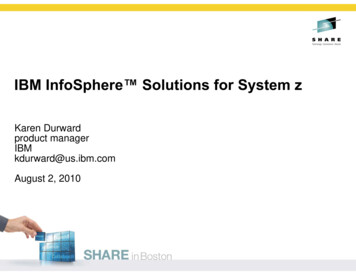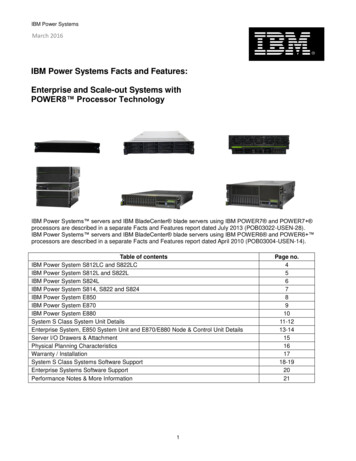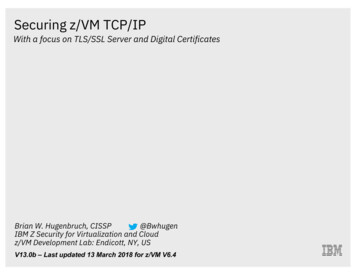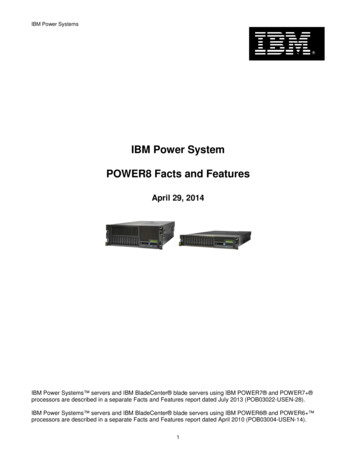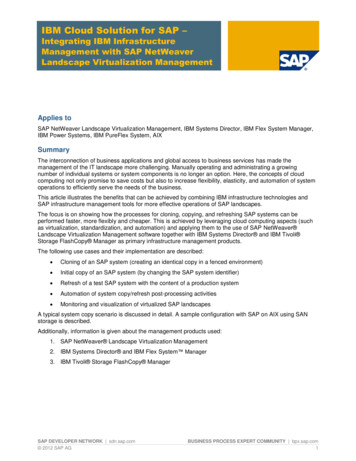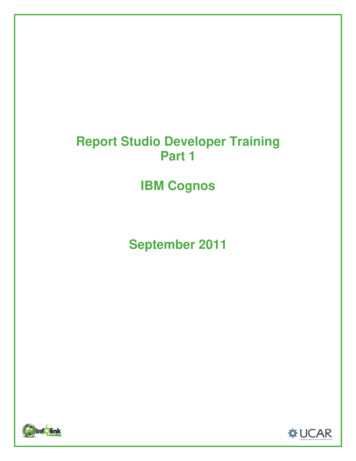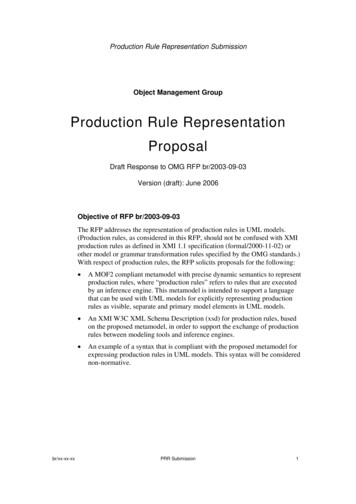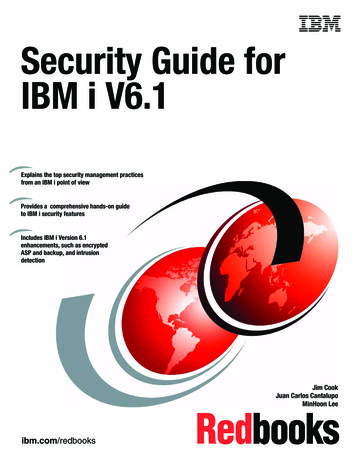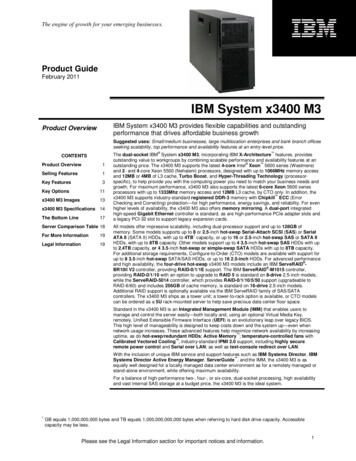
Transcription
The engine of growth for your emerging businesses.Product GuideFebruary 2011IBM System x3400 M3IBM System x3400 M3 provides flexible capabilities and outstandingperformance that drives affordable business growthProduct OverviewSuggested uses: Small/medium businesses, large multilocation enterprises and bank branch officesseeking scalability, top performance and availability features at an entry-level price. CONTENTSProduct Overview1Selling Features1Key Features3Key Options11x3400 M3 Images13x3400 M3 Specifications 14The Bottom Line17Server Comparison Table 18For More Information19Legal Information19 The dual-socket IBM System x3400 M3, incorporating IBM X-Architecture features, providesoutstanding value to workgroups by combining scalable performance and availability features at an outstanding price. The x3400 M3 supports the latest 4-core Intel Xeon 5600 series (Westmere)and 2- and 4-core Xeon 5500 (Nehalem) processors, designed with up to 1066MHz memory accessand 12MB or 4MB of L3 cache, Turbo Boost, and Hyper-Threading Technology (processorspecific), to help provide you with the computing power you need to match your business needs andgrowth. For maximum performance, x3400 M3 also supports the latest 6-core Xeon 5600 seriesprocessors with up to 1333Mhz memory access and 12MB L3 cache, by CTO only. In addition, the x3400 M3 supports industry-standard registered DDR-3 memory with Chipkill ECC (ErrorChecking and Correcting) protection—for high performance, energy savings, and reliability. For evenhigher levels of availability, the x3400 M3 also offers memory mirroring. A dual-port integratedhigh-speed Gigabit Ethernet controller is standard, as are high-performance PCIe adapter slots anda legacy PCI-32 slot to support legacy expansion cards.All models offer impressive scalability, including dual-processor support and up to 128GB ofmemory. Some models supports up to 8 or 2.5-inch hot-swap Serial-Attach SCSI (SAS) or Serial1ATA II (SATA II) HDDs, with up to 4TB capacity, or up to 16 or 2.5-inch hot-swap SAS or SATA IIHDDs, with up to 8TB capacity. Other models support up to 4 3.5-inch hot-swap SAS HDDs with upto 2.4TB capacity, or 4 3.5-inch hot-swap or simple-swap SATA HDDs with up to 8TB capacity.For additional storage requirements, Configure-to-Order (CTO) models are available with support forup to 8 3.5-inch hot-swap SATA/SAS HDDs, or up to 16 2.5-inch HDDs. For advanced performance and high availability, the four-drive hot-swap x3400 M3 models include an IBM ServeRAID BR10il V2 controller, providing RAID-0/1/1E support. The IBM ServeRAID -M1015 controller,providing RAID-0/1/10 with an option to upgrade to RAID 5 is standard on 8-drive 2.5-inch models,while the ServeRAID-5014 controller, which provides RAID-0/1/10/5/50 support (upgradeable toRAID-6/60) and includes 256GB of cache memory, is standard on 16-drive 2.5-inch models.Additional RAID support is optionally available via the IBM ServeRAID family of SAS/SATAcontrollers. The x3400 M3 ships as a tower unit; a tower-to-rack option is available, or CTO modelscan be ordered as a 5U rack-mounted server to help save precious data center floor space.Standard in the x3400 M3 is an Integrated Management Module (IMM) that enables users tomanage and control the server easily—both locally and, using an optional Virtual Media Key,remotely. Unified Extensible Firmware Interface (UEFI) is an evolutionary leap over legacy BIOS.This high level of manageability is designed to keep costs down and the system up—even whennetwork usage increases. These advanced features help maximize network availability by increasing uptime, as do hot-swap/redundant HDDs; Active Memory ; temperature-controlled fans with Calibrated Vectored Cooling ; industry-standard IPMI 2.0 support, including highly secureremote power control and Serial over LAN; as well as text-console redirect over LAN.With the inclusion of unique IBM service and support features such as IBM Systems Director, IBM Systems Director Active Energy Manager, ServerGuide , and the IMM, the x3400 M3 is asequally well designed for a locally managed data center environment as for a remotely managed orstand-alone environment, while offering maximum availability.For a balance of high-performance two-, four-, or six-core, dual-socket processing, high availabilityand vast internal SAS storage at a budget price, the x3400 M3 is the ideal system.1GB equals 1,000,000,000 bytes and TB equals 1,000,000,000,000 bytes when referring to hard disk drive capacity. Accessiblecapacity may be less.Please see the Legal Information section for important notices and information.1
The engine of growth for your emerging businesses.Selling FeaturesPrice/PerformanceThe x3400 M3 offers numerous features to boost performance and reduce product and operatingcosts: Up to two 4- or 6-core Xeon 5600 Series processors and 12MB of shared cache per processor,offer superior performance capable of tackling the toughest jobs. 2- and 4-core Xeon 5500 seriesprocessors are available for lower entry points. Xeon 5600 series processors offer up to 43%better performance than the previous-generation 5500 series processors and up to 900% betterperformance than the single-core processors of a few years ago that you may still be using. Sixteen DIMMs of fast registered 1333MHz (or 1066MHz) DDR3 ECC memory with Chipkillprotection (optional) provides speed, high availability, and a memory capacity of up 128GB.2 Four high-speed PCIe Gen 2 adapter slots offer investment protection by supporting high performance adapters, such as 10Gb Ethernet, Fibre Channel and InfiniBand cards, none ofwhich will run in older conventional PCI slots. A legacy PCI/33 adapter slot offers support for olderadapters. The integrated ServeRAID-BR10il V2 controller (model-specific) provides RAID-0/1/1E and fullduplex (bidirectional 3GBps) data transfers for SAS/SATA/SSD drives. Other server modelsinclude the 6Gbps ServeRAID-M1015 controller standard, which provides RAID-0/1/10/5(optional RAID-50/6/60 with Self-Encrypting Disk, or SED) or the 6Gbps ServeRAID-M5014controller standard, which provides RAID-0/1/10/5/50 (optional 6/60 with SED). Support for up to 4 3.5-inch hot-swap SAS or SATA II hard disk drives or up to 16 2.5-inch hotswap SAS/SATA drives offers high-performance with high availability (model-specific). Theintegrated SAS controller provides full-duplex 6Gbps data transfers for SAS drives. For lower costand high capacity, other models support up to 4 simple-swap SATA II drives. CTO models areavailable to support 8 3.5-inch hot-swap SAS or SATA II drives. The integrated dual-port Gigabit Ethernet controller with IPMI 2.0 support provides high-speednetwork communications. A high degree of device integration, including SAS/SATA, Gigabit Ethernet, systemsmanagement and video controllers, lowers costs and frees up valuable adapter slots. Energy-efficient components, including low-voltage transistors and voltage regulator modules,and power supplies that are up to 90% efficient, help keep your energy bills down.FlexibilityThe x3400 M3 has the ability to grow with your application requirements, thanks to: A choice of 2-core or 4-core processors starting at 1.6GHz and up to 2.66GHz clock rates, up to5.86 Gigatransfers per second (GTps), and 80W maximum power draw. For more advancedprocessing power, a choice of 6-core processors up to 3.06GHz clock rates and 6.4 GTps with95W power draw is available via CTO. Up to 128GB of high-speed registered DDR-3 system memory. Five available high-performance PCIe adapter slots and one legacy PCI slot in all models.Optionally, a riser card supporting two PCI-X/133 adapters or one additional PCIe can beselected via Configure-to-Order (CTO) models. Upgrading to the ServeRAID-M5014 or ServeRAID-M5015 controller provides 256MB or 512MBof battery-backed cache (respectively) to enable higher-performance hardware RAID support, andallows the x3400 M3 to offer five RAID levels standard: RAID-0/1/10/5/50 (and optionally 6/60with Self-Encrypting Disk).3 The eight USB 2.0 ports (six external, two internal) are up to 40X faster than older USB 1.1ports. This provides speedy access to external HDDs (non-arrayed), floppy drives, flash drives,optical drives, tape drives, and other USB devices. Two ports are on the front of the unit and fourare on the back. Up to 4 internal 3.5-inch simple- or hot-swap SATA, or hot-swap SAS HDDs, or up to 16 2.5inch hot-swap SAS or SATA drives, plus 5.25-inch bays for a half- or full-high tape drive arestandard. CTO models are available to increase 3.5-inch storage support to a maximum of 8 3.5inch hot-swap SAS/SATA drives (with no tape drive support and slim optical device only). Thistranslates into as much as 16TB of internal 3.5-inch hot-swap SAS or SATA, 8GB of 3.5-inchsimple-swap SATA, 9.6TB of 2.5-inch hot-swap SAS, or 8TB of 2.5-inch hot-swap SATAstorage, providing tremendous internal storage capability, along with full data backup.Manageability / SecurityPowerful systems management features simplify local and remote management of the x3400 M3: The x3400 M3 includes an Integrated Management Module (IMM) to monitor server availability,23All models require Chipkill-enabled DIMMs for Chipkill protection.Data transfer rates may be less than the maximum possible.Please see the Legal Information section for important notices and information.2
The engine of growth for your emerging businesses.perform Predictive Failure Analysis, etc., and trigger IBM Systems Director alerts. The IMMperforms the functions of both the Baseboard Management Controller (BMC) of earlier systemsand the Remote Supervisor Adapter II and is upgradeable to remote presence/cKVM. An optional Virtual Media Key provides additional systems management capabilities, includingWeb-based out-of-band control; virtual floppy and optical drive support; Windows “blue screen”error capture; LDAP and SSL support; and remote redirection of PCI video, text, keyboard andmouse (cKVM). And it does all this without consuming a valuable adapter slot. UEFI — The Unified Extensible Firmware Interface is the next generation of BIOS, providinggreater manageability and function. Used in PCs for several years, it is now moving into theserver arena. IBM is the first to incorporate UEFI in our new servers. Features include: Human readable event logs — no more beep codes Complete out-of-band coverage by the Advance Settings Utility to simplify remote setup A complete setup solution, allowing adapter configuration functions to be moved into UEFI Consistent firmware management across an entire product line Integrated IPMI 2.0 support alerts IBM Systems Director to anomalous environmental factors,such as voltage and thermal conditions. It also supports highly secure remote power controlusing data encryption. Text Console Redirection support allows the administrator to remotely and securely view x3400M3 text messages over Serial or LAN. Integrated Trusted Platform Module (TPM) 1.2 support. The completely redesigned IBM Systems Director is included for proactive systemsmanagement. IBM Systems Director comes with a portfolio of tools, including Active EnergyManager, and Service and Support Manager. In addition, IBM Systems Director offers extendedsystems management tools for additional server management and increased availability. When aproblem is encountered, IBM Systems Director can issue administrator alerts via e-mail, pager,and other methods. IBM Systems Director Active Energy Manager , an IBM-exclusive, is designed to takeadvantage of new system power management features, by providing power monitoring features. The optional Virtual Media key provides IMM remote presence and it does this without consuminga valuable adapter slot.Availability and ServiceabilityThe x3400 M3 provides many features to simplify serviceability and increase system uptime:4 x3400 M3 servers offer Chipkill ECC memory protection (when using x4 DIMMs), standard onsome models and optional on others. Chipkill memory is up to 16X better than standard ECCmemory at correcting memory errors. This can help reduce downtime caused by memory errors. The x3400 M3 offers memory mirroring for redundancy in the event of a non-correctablememory failure Toolless cover removal provides easy access to upgrades and serviceable parts. Similarly, theintegrated ServeRAID-BR10il V2 controller, the optional IMM Virtual Media Key, and theoptional ServeRAID-M5014 controller can be installed and serviced without tools. This meansless time (and therefore less money) spent servicing the x3400 M3. Additionally, hotswap/redundant HDDs and power supplies (model dependent), as well as Chipkill memoryprotection and mirrored memory, mean greater system uptime while these components are beingserviced. Environmental monitoring with fan speed control for temperature, voltages, fan failure, powersupply failure, and power backplane failure. IPMI 2.0 supports highly secure remote system power control using data encryption. This allowsan administrator to restart a server without having to visit it in person, saving travel time andgetting the server back up and running quickly and securely. It also adds new features to thoseprovided by IPMI 1.5, including VLAN support, Serial over LAN, enhanced authentication andencryption algorithms (RMCP and AES) and a firmware firewall. Temperature-controlled fans adjust to compensate for changing thermal characteristics. At thelower speeds they draw less energy and suffer less wear. Equally important in a crowded datacenter, temperature-controlled fans produce less ambient noise in the data center than if theywere constantly running at full speed.5 The three-year (parts and labor) limited onsite warranty offered on Machine Type 7379 helpsafford you peace of mind and greater investment protection than a one-year warranty does.45Chipkill protection is supported with x4 DDR3 RDIMMs, but not x8 RDIMMs.For terms and conditions or copies of the IBM Statement of Limited Warranty, call 800-772-2227 in the U.S. In Canada call 800426-2255. Telephone support may be subject to additional charges. For warranties including onsite labor, a technician is sent afterIBM attempts to resolve the problem remotely. International warranty service is available in countries in which this product is sold.Please see the Legal Information section for important notices and information.3
The engine of growth for your emerging businesses.Key FeaturesHigh-Performance Xeon 5600 and 5500 Series ProcessorsThe x3400 M3 supports up to two high-performance Intel Xeon processors, allowing you to upgradeto a second processor as business needs require. The x3400 M3 offers a choice of processor clockrates, memory access speeds and power draw: 80W 6-core Xeon 5600 series models E5649 or E5645 at 2.53 or 2.4GHz (respectively),achieving up to 5.86GTps (gigatransfers per second) with 12MB of L3 processor cache,1333MHz memory access, 2 threads per core, and Intel Turbo Boost and Hyper Threadingtechnology. 80W 4-core Xeon 5600 series models E5640, E5630, E5620, E5606, or E5603 at 2.66, 2.53,2.40, 2.13, or 1.60GHz (respectively), achieving up to 5.86GTps (gigatransfers per second) with12MB of L3 processor cache, 1066MHz memory access, 2 threads per core, and Intel TurboBoost and Hyper Threading technology 80W 4-core Xeon 5600 series model E5607 at 2.26GHz, achieving up to 5.86GTps (gigatransfersper second) with 12MB of L3 processor cache, and 1066MHz memory access 60W 6-core Xeon 5600 series model L5640 at 2.26GHz, achieving up to 5.86GTps with 12MB ofL3 processor cache, 1333MHz memory access, 2 threads per core, and Intel Turbo Boost andHyper Threading technology 40W 4-core Xeon 5600 series model L5630 at 2.13GHz, achieving up to 5.86GTps with 12MB ofL3 processor cache, 1066MHz memory access, 2 threads per core, and Intel Turbo Boost andHyper Threading technology 40W 4-core Xeon 5600 series model L5609 at 1.86GHz, achieving up to 4.8GTps with 12MB ofL3 processor cache, and 1066MHz memory access 80W 4-core Xeon 5500 series models E5507 or E5506 at 2.26GHz or 2.13GHz (respectively),achieving up to 4.8GTps with 4MB of L3 processor cache, and 800MHz memory access. 80W 2-core Xeon 5500 series model E5502 at 1.86GHz achieving up to 4.8GTps with 4MB of L3processor cache, and 800MHz memory access.Other Xeon 5600 and 5500 series processors, available via CTO, include: 95W 6-core Xeon 5600 series models X5675, X5670, X5660 or X5650 at 3.06, 2.93, 2.80 or2.66GHz (respectively) achieving up to 6.4GTps with 12MB of L3 processor cache, 1333MHzmemory access, 2 threads per core, and Intel Turbo Boost and Hyper Threading technology. 80W 4-core Xeon 5500 series models E5540, E5530, and E5520 at 2.53, 2.4, and 2.26GHz(respectively), achieving up to 5.86GTps with 8MB of L3 processor cache, 1066MHz memoryaccess, 2 threads per core, and Intel Turbo Boost and Hyper Threading technology 80W 4-core Xeon 5500 series model E5504 at 2.0GHz, achieving up to 4.8GTps with 4MB of L3processor cache, and 800MHz memory accessWith the Xeon 5600 Series processors, Intel has diverged from its traditional SymmetricMultiprocessing (SMP) architecture to a Non-Uniform Memory Access (NUMA) architecture. TheXeon 5600 processors are connected through a serial coherency link called QuickPath Interconnect(QPI). QPI is capable of 6.4, 5.86 or 4.8 GTps (gigatransfers per second), depending on theprocessor model.Six-core Xeon processors contain six complete processor cores. Processors contain one shared12MB L3 cache. The cache is dynamically allocated between the cores as needed. The multiplecores appear to software as multiple physical processors. Six-core processors offer considerablyhigher performance than a same-speed Xeon processor with two cores.Turbo Boost Technology increases performance by translating the temperature, power and currenthead room into higher frequency. It will dynamically increase by 133MHz for short and regularintervals until the upper limit is met or the maximum possible upside for the number of active cores isreached. The maximum frequency is dependent on the number of active cores. The amount of timethe processor spends in the Turbo Boost Technology state depends on the workload and operatingenvironment, providing the performance you need, when and where you need it. For example, a2.8GHz 6-core X5660 processor with 3-6 cores active can run the cores at 3.06GHz. With only 1 or2 cores active, the same processor can run those cores at 3.2GHz. Similarly, a 2.40GHz 4-coreE5620 processor can run at 2.53GHz or even 2.66GHz. When the inactive cores are needed again,they are dynamically turned back on and the processor frequency is adjusted accordingly.Intelligent Power Capability powers individual processor elements on and off as needed, to reducepower draw.Execute Disable Bit functionality can help prevent certain classes of malicious buffer overflowattacks when combined with a supporting operating system.Intel’s Virtualization Technology (VT) integrates hardware-level virtualization hooks that allowoperating system vendors to better utilize the hardware for virtualization workloads.Please see the Legal Information section for important notices and information.4
The engine of growth for your emerging businesses.DDR-3 Registered Memory with Chipkill ECC ProtectionThe x3400 M3 ships with registered double data rate III (DDR-3) memory and provides ActiveMemory features, including advanced Chipkill memory protection (optionally), for up to 16X bettererror correction than standard ECC memory. In addition to offering better performance than DDR-2or fully-buffered memory, DDR-3 memory also uses less energy. DDR-2 memory already offered upto 37% lower energy use than fully buffered memory. Now, a generation later, DDR-3 memory iseven more efficient, using 22% less energy than DDR-2 memory.The x3400 M3 supports up to 128GB of RDIMM (registered DIMM) memory in 16 DIMM slots, or upto 48GB of UDIMM (unbuffered DIMM) memory in 12 slots. Redesign in the architecture of the Xeon5600 series processors bring radical changes in the way memory works in these servers. Forexample, the Xeon 5600 series processor integrates the memory controller inside the processor,resulting in two memory controllers in a 2-socket system. Each memory controller has three memorychannels. Depending on the type of memory, population of memory, and processor model, thememory may be clocked at 1066MHz or 1333Mhz.Note: If only one processor is installed, only the first eight DIMM slots can be used. Adding a secondprocessor not only doubles the amount of memory available for use, but also doubles the number ofmemory controllers, thus doubling the system memory bandwidth. If you add a second processor,but no additional memory for the second processor, the second processor has to access the memoryfrom the first processor “remotely,” resulting in longer latencies and lower performance. The latencyto access remote memory is almost 75% higher than local memory access. So, the goal should be toalways populate both processors with memory.Xeon 5600 / 5500Processor 0Xeon 5600 / 5500Processor 1QPIMemory ControllerCh0Ch174D1D21Ch285D4D5Memory 1411D15D1610D11D141-16: DIMM population sequence; D1-D16: DIMM slot assignmentsThe E5603, E5606, E5607, and E5620 processors support up to 1066MHz clock speed. Using1066MHz memory (where supported) versus 800MHz offers up to 28% better performance. X5650through X5675 processors, supporting up to 1333MHz clock speed, are available via CTO,Xeon 5600 series processors access memory with almost 50% lower latency than the earlier 5400series processors. That can result in faster processing of latency-sensitive workloads.This new processor design comes with some trade-offs in memory capacity, performance, and cost:For example, greater memory capacity comes with lower memory speed. Alternatively, it ispossible to achieve the same memory capacity at lower cost but at a lower memory speed.Regardless of memory speed, the Xeon 5600 platform represents a significant improvement inmemory bandwidth over the previous Xeon 5400 platform. This improvement is mainly due to thedual integrated memory controllers and faster DDR-3 memory. Throughput at 800MHz is 25gigabytes per second (GBps); at 1066MHz it’s 32GBps; and at 1333MHz it’s 35GBps. The newXeon 5600 series processor also supports low voltage (LV) 1.35V DIMMs.Memory interleaving refers to how physical memory is interleaved across the physical DIMMs. Abalanced system provides the best interleaving. A Xeon 5600 processor-based system is balancedwhen all memory channels on a socket have the same amount of memory.A memory rank is simply a segment of memory that is addressed by a specific address bit. DIMMstypically have 1, 2 or 4 memory ranks, as indicated by their size designation. A typical memory DIMM description is 2GB 4Rx8 DIMM The 4R designator is the rank count for this particular DIMM (4R quad-rank) The x8 designator is the data width of the rankIt is important to ensure that DIMMs with appropriate number of ranks are populated in each channelPlease see the Legal Information section for important notices and information.5
The engine of growth for your emerging businesses.system. Dual-rank DIMMs offer better interleaving and hence better performance than single-rankDIMMs. For instance, a system populated with six 2GB dual-rank DIMMs outperforms a systempopulated with six 2GB single-rank DIMMs by 7% for SPECjbb2005. Dual-rank DIMMs are alsobetter than quad-rank DIMMs because quad-rank DIMMs will cause the memory speed to bedown-clocked.Another important guideline is to populate equivalent ranks per channel. For instance, mixing onesingle-rank DIMM and one dual-rank DIMM in a channel should be avoided.Note: It is important to ensure that all three memory channels in each processor are populated. Therelative memory bandwidth decreases as the number of channels populated decreases. This isbecause the bandwidth of all the memory channels is utilized to support the capability of theprocessor. So, as the channels are decreased, the burden to support the requisite bandwidth isincreased on the remaining channels, causing them to become a bottleneck.RDIMMs and UDIMMs cannot be used in the same server. Different brands of DIMMs should not bemixed, due to possible timing issues.For increased availability, the x3400 M3 offers an additional (but mutually exclusive) level of IBMActive Memory protection: online memory mirroring.Memory mirroring works much like disk mirroring. The total memory is divided into two channels.Data is written concurrently to both channels. If a DIMM fails in one of the DIMMs in the primarychannel, it is instantly disabled and the mirrored (backup) memory in the other channel becomesactive (primary) until the failing DIMM is replaced. One-half of total memory is available for use withmirroring enabled. (Note: Due to the double writes to memory, performance is affected.)Mirroring is handled at the hardware level; no operating system support is required.DDR3 memory is currently available in 1GB, 2GB, 4GB and 8GB RDIMMs, or 1GB, 2GB, and 4GBUDIMMs. DIMMs are installed individually (not in pairs). However, for performance reasons, in a 2processor system, it’s best to install matching DIMMs for each processor.Maximum memory capacity and speed in 2-processor configurations include:Memory FrequencyDIMMs perChannelMax. MemoryCapacityProcessors1333MHz (CTO only)1(6 DIMMs)48GB RDIMM24GB UDIMMX5650 and above1333MHz (CTO only)2(12 DIMMs)96GB RDIMM48GB UDIMMX5650 and above1066MHz2(12 DIMMs)96GB RDIMM48GB UDIMME5603 and above800MHz3(16 DIMMs)128GB RDIMM48GB UDIMME5603, and above800MHz-1333MHz(Mirroring)3(12 DIMMs)96GB RDIMM24GB UDIMME5603, L5609, and aboveHot-Swap/Redundant ComponentsSystem availability is maximized through the extensive use of hot-swap and redundant components,including: Redundant memory protection (with memory mirroring enabled) and optional Chipkillprotection Hot-swap, redundant hard disk drives (with RAID protection standard) Hot-swap, redundant power supplies (model dependent)High-Performance Adapter SlotsThe x3400 M3 provides six adapter slots standard: five PCIe Gen 2 slots and one legacy PCI slot.PCI Express Gen 2 is the next-generation of high-performance, low-latency, serial I/O bus. Slot 2 isa x16 (“by 16”) physical/x8 electrical PCIe (PCI Express) Gen 2 slot. This means that although theslot runs at x8 Gen 2 speeds (8GBps), it can accept a x16 Gen 2 adapter in the slot. It is alsocapable of supporting x1/x4/x8 adapters at full speed. In addition to this slot, the x3400 M3 alsoincludes two x8 physical/x8 electrical Gen 2 slots (8GBps), two x8 physical/x4 electrical Gen 2slots (4GBps), and one 33MHz legacy PCI slot. As part of a configure-to-order (CTO) build, twochoices of riser card can be added, with either two 133MHz PCI-X slots (8 total) or one PCIe x8physical/x4 electrical Gen 1 (2GBps) slot (7 total).Slot 1 is a half-length/full-height PCIe slot; slots 2, 3, 4 and 5 are full-length/full-height PCIePlease see the Legal Information section for important notices and information.6
The engine of growth for your emerging businesses.slots, and Slot 6 is a half-length/full-height 33MHz legacy PCI slot. The PCI-X riser contains twofull-length/full-height slots.Disk/Tape ControllersAll 3.5-inch hot-swap x3400 M3 models include an integrated hardware-based IBM ServeRAIDBR10il V2 SAS/SATA controller. This controller supports SAS and SATA drives. (Simple-swapmodels use the SATA support incorporated in the system chipset.) The ServeRAID-M1015SAS/SATA controller is included in the hot-swap models featuring eight 2.5-inch drives. SupportedServeRAID controllers include:6The 3Gbps (x4 PCIe) ServeRAID-BR10il V2 controller offers hardware RAID-0/1/1E support (nocache) for up to 4 HDDs.The standard/optional 6Gbps (x8 PCIe) ServeRAID-1015 SAS/SATA controller supports RAID0/1/10 (no cache) for up to 32 drives (limited to available bays). The IBM ServeRAID M1000 SeriesAdvance Feature Key adds RAID-5 and Self-Encrypting Disk (SED) support.The standard/optional 6Gbps (x8 PCIe) ServeRAID-M5014 SAS/SATA controller offers enhancedperformance with 256MB of cache memory, and supports RAID-0/1/10/5/50 for up to 32 drives(limited to available bays).The optional 6Gbps (x8 PCIe) ServeRAID-M5015 SAS/SATA controller offers enhancedperformance with 512MB of cache memory and battery backup, and supports RAID-0/1/10/5/50 forup to 32 drives (limited to available bays).The optional IBM ServeRAID M5000 Series Advance Feature Key adds RAID-6/60 and SEDsupport to the M5014 and M5015. The IBM ServeRAID M5000 Series Battery Key adds batterybackup support to the M5014.For external storage, the 3GBps ServeRAID-MR10M controller enables connection to up to four IBMSystem Storage EXP3000 SAS expansion units (48 HDDs total). It provides RAID-0/1/10/5/50support and 256MB of onboard cache.x3400 M3 models with the ServeRAID-BR10il V2 controller installed can be upgraded to any of theother ServeRAID controllers. Those with the M1015 controller standard can upgrade to the M5014 or5015 controller. Models equipped with the ServeRAID-M5015 controller can upgrade to the 5015controller. Any of them can be replaced with the MR10M controller for external storage needs, or itcan be installed additionally in one of the standard PCIe slots.Drive BaysThe x3400 M3 can contain up to 19 drive bays (in 2.5-inch models) or 11 bays (in 3.5-inch) models.2.5-inch models support either 8 or 16 (model-specific) small form-factor (SFF) hot-swap SAS orSATA II drives standard. 3.5-inch models support 4 hot-swap SAS or SATA II drives, or 4 simpleswap SATA II drives standard. Support for 8 3.5-inch 2.5-inch drives is available by CTO. Inaddition, there are 3 5.25-inch bays standard for tape and optical drives.An internal fu
In addition, IBM Systems Director offers extended systems management tools for additional server management and increased availability. When a problem is encountered, IBM Systems Director can issue administrator alerts via e-mail, pager, and other methods. IBM Systems Director Active Energy Manager , a

